#any wallace and gromit fans in the crowd
Explore tagged Tumblr posts
Text
piella is highkey real as fuck bc if i was the face of bake-o-light and then i ate a shit ton of bread (WHICH BY THE WAY IS THE WAY IS ADVERTISED FOR KEEPING YOU THIN) and gained loads of weight and then they FIRED ME bc of it i too would go absolutely insane and start murdering bakers
#does anyone know what im talking about#any wallace and gromit fans in the crowd#jess yaps。*♡#wallace and gromit a matter of loaf and death#wallace and gromit
12 notes
·
View notes
Text
Ray Harryhausen’s Sympathetic Portrayal of the Stop-motion Creature: The Clash of Stop-motion Fantasy Against Live-action Reality
The following was adapted from a presentation I gave at 2019 Doctoral College Conference held by the University of Surrey. It is part of a broader project on the history of US stop-motion and acts as a brief window into a chapter in progress on Ray Harryhausen and his films. The presentation was 10 minutes long with questions, and was intended for audiences who would be interested in the subject matter, but not necessarily be experts in the field of stop-motion, special effects, or even animation or film studies. This is a deviation from the film reviews and articles I do on this blog, but adapting parts of my academic research into smaller, digestible pieces like this is something I’d like to do more of in the future. So read, enjoy, and, by all means, provide feedback!

The man you see in the image above is Ray Harryhausen. I expect that name will be familiar to at least some of you if you are fans of classic US fantasy adventure films like Jason and the Argonauts or Clash of the Titans, as Ray Harryhausen was the animator who provided the special effects for not only these films, but thirteen other fantasy and sci-fi films ranging from the 1950s to the early 1980s. The action sequences of these features showcased live-action actors interacting with beasts, statuesque golems, and an assortment of supernatural creatures which Harryhausen would render through the medium of stop-motion. This method of animation involves a physical model being photographed one frame at a time as the animator manipulates the model to create incremental movements which come together to form coherent movement when projected on screen, with a contemporary example being Wallace & Gromit. Harryhausen would intersplice his stop-motion animation with live-action footage using a ‘split-screen rear-projection process’. The live-action component of the sequence would be filmed first, then projected onto a rear screen and the stop-motion animation would be shot in front of this screen. Harryhausen’s legacy of stop-motion animation makes him a key figure in any study of the history of both special effects and stop-motion, but his reputation extends not only to practitioners of these disciplines, but to the filmgoing public and to directors like Peter Jackson, James Cameron, and Guillermo del Toro.


Part of this can be attributed to the marketing of these films, which can be observed in these stills taken from the original trailer for the 1958 film The 7th Voyage of Sinbad. The trailer showcases sequences from the film which feature Harryhausen’s effects, repeatedly proclaiming ‘This is Dynamation!’, a term devised to distinguish Harryhausen’s stop-motion from more traditional forms of animation. The perception of these effects was important in the marketing for these films as features like this trailer indicate that this process of Dynamation wasn’t just implemented as a piece of technical trickery to be kept secret behind the curtain, but was proudly displayed as a means of drawing viewers in to watch these films. The Dynamation for these key action sequences is embedded in the perceived identity of these films. But if that is the case, what can be said about the identity of the stop-motion characters who are front and centre in these memorable sequences, Harryhausen’s assortment of Dynamation creatures? Having established how Harryhausen and his effects became so widely known, I propose that the status of these animated creatures as the main visual attraction for these films makes them not simply dangerous and repulsive monsters we want to see the heroes vanquish along their journeys, but rather presents them as fantastical creatures who audiences are encouraged to revel in the act of witnessing them; they are not repulsive, but attractive for viewers. Therefore, I’m going to suggest in my talk today that, for as dangerous as these creatures may be in the context of the narrative, there is an element at play in these films which allows for the possibility for audiences to become enamoured with these monsters, and even lament their passing when they are eventually defeated.

An element of this tragic component can be traced back to one of the most important influences on Harryhausen’s career as a stop-motion animator – Willis O’Brien, the special effects artist for such films as 1925’s The Lost World, and, most famously the original 1933 King Kong, which Harryhausen has repeatedly cited as the film that sparked his interest in stop-motion, eventually leading to him working under Willis O’Brien as an assistant animator on Mighty Joe Young in 1949. Harryhausen would evoke particularly iconic moments from King Kong, the film that had such an effect on him, in his own work.

In King Kong, there is a sequence in which the female lead, Ann, is captured by the native people of Skull Island and offered up to Kong as a sacrifice. Scenes with similar set-ups can be observed in Clash of the Titans and Sinbad and the Golden Voyage, in which the people of Joppa offer princess Andromeda to the Kraken and Margiana is presented as a sacrifice to the One-Eyed Centaur respectively. These scenes call to mind the recognisable imagery of the iconic first appearance of Kong in his original film, creating parallels between these creatures and Kong as each monster towers over a woman being offered to them as a sacrifice. This paints these monsters as imposing threats, but it also frames them as creatures who are revered within the narrative, encouraging the audience to also be taken aback by these creatures as they make their grand entrances.


With these associations with Kong being made, each film builds on this connection with King Kong by having these creatures share Kong’s fate. At the end of King Kong, the ape meets a tragic end as the planes shoot him down from the Empire State Building. It’s a memorably tragic conclusion to Kong’s tale as humans bring him out of his natural environment and place him in a man-made city in which he is so incompatible that it results in the death of this unique creature. In Clash of the Titans, Perseus arrives on the scene of Andromeda’s sacrifice and presents the Kraken with the head of the Medusa, turning it to stone whereupon the Kraken collapses under its own weight. The Kraken may not be visibly conflicted over inflicting harm on human characters (as opposed to Kong and his protectiveness over Ann), but much like how Kong was brought to New York in chains, the film twice shows the audience that the Kraken is kept in a cage by the Gods of Olympus, let loose only when it suits their purposes. The Kraken, a Titan who once ruled over the Earth before the Gods took over, is reduced to a prisoner, just as Kong was a king on Skull Island, but is brought to New York to entertain crowds. The Kraken is framed as being much less than he once was, before he is destroyed by the live-action human characters in the film.

After the Centaur carries Margiana away in The Golden Voyage of Sinbad, he appears in the film’s climax assisting the film’s villain before being brought down by Sinbad as he repeatedly stabs him in the back. Despite being explicitly labelled as a ‘Guardian of Evil’ by the film’s dialogue, the Centaur does not harm Margiana, just as Kong does not harm Ann. Additionally, the animation of the Centaur’s death throes continue for some time, lingering on the creature’s pain as it gasps for air and unsuccessfully struggles to remove Sinbad’s dagger from the back of his shoulder before finally dying. Through Harryhausen establishing parallels between these creatures and Kong’s status as a revered and imposing beast, these similarly violent ends at the hands of the human characters has the potential to be read as the loss of something unique, and perhaps even a creature that has been mistreated and misused by the sentient humans and human-like Gods around them.

While the deaths of Harryhausen’s creatures should logically represent a victory for the live-action heroes of these films, there is nevertheless a heavy weight to the moment when these creatures cease to move, which encourages viewers to consider what has been lost. Now that I’ve established the connection between some of Harryhausen’s creatures and King Kong’s story, I’m going to examine how stop-motion contributes to the sense of loss in these scenes. The movement of stop-motion carries an inherent connection to the uncanny, a psychological phenomenon which is associated with that momentary unease we experience when we’re uncertain whether to register an object, person, or scenario as either familiar or unfamiliar, alive or dead. The physicality of stop-motion models gives them the appearance of puppets and dolls, and, as Paul Wells says, ‘the puppet is the embodiment of some degree of living spirit and energy but also inhuman and remote’. While the uncanny nature of stop-motion is an indication of a viewer being somewhat conscious of the puppet’s lifeless quality as an inanimate object in the real world, it simultaneously indicates the audience’s recognition of the life-like qualities of the puppet’s performance. However, in these moments where Harryhausen’s creatures cease to move, that tension between life and the absence of life ceases to be, marking a clear distinction from when the creature appeared to be active, albeit in an uncanny fashion, and its deathly inertness. Once they stop moving, the uncanniness dissipates, making the shift in how we perceive the character or creature being rendered in stop-motion that much more pronounced. The death scenes for each of Harryhausen’s creatures carry that much more impact because the uncanniness of stop-motion makes us aware of what life is being instilled in these physical models while they are alive in the context of the narrative.

The final shot of 1953’s The Beast from 20,000 Fathoms focuses not on the human characters, but on the death of the Rhedosaurus. As the silhouette of its body is cast against the flames, the film calls to mind the destruction caused by this creature, and yet its motionless body contrasts against the flickering flames, emphasising its lifelessness even further. Earlier in the film, a professor expresses wonder at seeing the Rhedosaurus. Even though his fascination with the creature results in his death, the acknowledgement of this perspective that the Rhedosaurus is a source of amazement recognises the fantastic spectacle of this creature – that the camera’s gaze in the film’s final moments rests not on the human characters but on the Rhedosaurus is an indication of how invested the audience is expected to be in this creature’s ultimate fate. The lingering shot of its inert body invites the possibility that its death is indeed lamentable.

Harryhausen’s Dynamation creatures are embedded in the history of US special effects cinema, and yet in the discussion of the relationship between narrative and US stop-motion, they occupy a curious space. It could be argued that they merely serve as a vehicle for the action sequences for these films, and that they aren’t meaningfully characterised. But I hope I have successfully presented the possibility today that, as the main source of attraction and the most enduring element of these films, the Harryhausen creatures engender a sense of fantastical wonder to them which, when paired with allusions to the imposing and tragic qualities of King Kong’s character and story, as well as the impact of seeing a stop-motion model suddenly become inert and entirely lifeless, has the capacity to instil feelings of regret at the lamentable loss of these unique creatures in the world of these narratives.
7 notes
·
View notes
Text
Epic Movie (Re)Watch #166 - Wallace & Gromit: The Curse of the Were-Rabbit

Spoilers Below
Have I seen it before: Yes
Did I like it then: Yes.
Do I remember it: Mostly.
Did I see it in theaters: No.
Format: DVD
This post is dedicated to the memory of Peter Sallis, who passed away while I was writing. The voice of Wallace, we’ll remember always the love he had for his dog and how he was crackers for cheese.
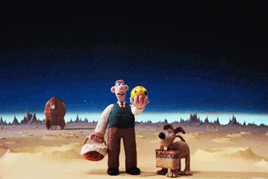
1) Wallace and Gromit were the stars of three original short films published by Aardman animation before this movie was released. All of them were directed by this film’s director: Nick Park. All of them were nominated for an Oscar for best animated short film. The final two (“The Wrong Trousers” and “A Close Shave”) won that Oscar. Wallace and Gromit are icons of not only British animation but animation in general, yet this is their only feature film to date. Having said that...
2) According to IMDb:
Nick Park wanted the DreamWorks logo to play an epic theme, like something akin to Star Wars: Episode IV - A New Hope (1977). He wanted audiences to think that Aardman had sold out to Hollywood, before the film reverts to the classic Wallace & Gromit theme over the opening credits. The intro was also one of the last scenes filmed.
3) As the opening credits play the camera pans across a series of family photos featuring the titular pair, telling it’s own little story in them. It’s actually a perfect way to introduce their relationship: Wallace’s love for cheese, Gromit’s sort of impatience with Wallace’s shenanigans, but also the deep friendship they have.
4) The vegetable shop in this film is called Harvey’s.

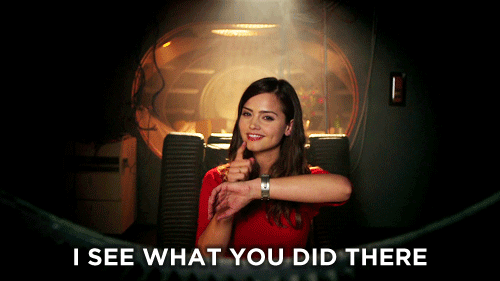
5) Peter Sallis as Wallace is a delightful treat.

Dreamworks originally wanted the performer - who had played the character since “A Grand Day Out” was released in 1989 - replaced by a bigger star. Nick Park firmly refused (casting Helena Bonham Carter and Ralph Fiennes in original roles to give Dreamworks this desire) and the film is better for it. Having a big name voice Wallace would be distracting. Sallis defined who Wallace was, playing the character until 2008′s “A Matter of Loaf and Death” (which is his last performance as the character). He brings with him a charmingly dimwitted yet sincere nature. There is no malice in Wallace, no annoyance. He is a totally warm and lovable character and I am grateful to Sallis for bringing that to him.
As I’m writing this I see that Peter Sallis has just passed away at 96. His agents announced, “It is with sadness that we announce that our client Peter Sallis died peacefully, with his family by his side, at Denville Hall on Friday 2 June.” I dedicated this post to his memory above but would be remise if I did not emphasis just how much of an impact he not only had on this series, but the world of voice over animation as a whole with his iconic character of Wallace.
6) Gromit is one of the finest examples of character animation ever.
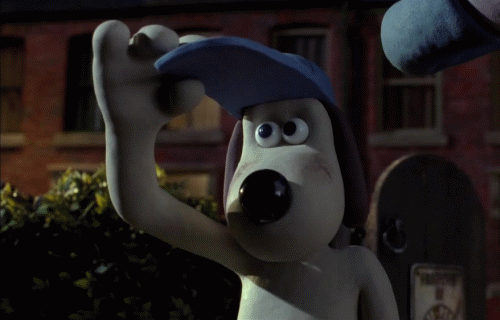
Gromit has the strongest personality of any character in the film without voice or even a mouth. His snark, his heart, his humor, who he is, is ALL in the eyes. In the movement of his eyebrows. It is truly remarkable when you think about it, especially considering how iconic a character he has become.
7) I have never related to a character as on this subject as deeply as I do with Wallace.
Wallace: “The fact is, I’m just crackers about cheese!”
8) Helena Bonham Carter as Lady Tottington.
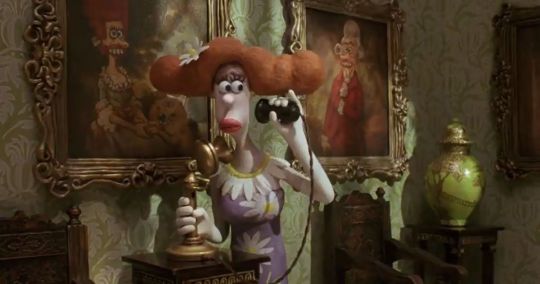
Bonham Carter is one of the most sincere voice over performers I’ve ever heard, with her role in Corpse Bride just as delightful as in this film. There is no ego to Tottington, you don’t even think you’re listening to Bonham Carter. You are listening to the optimistic, earnest, trusting, kind, and sympathetic Lady Tottington and I think that works wonderfully.
9) Ralph Fiennes as Victor Quartermain.
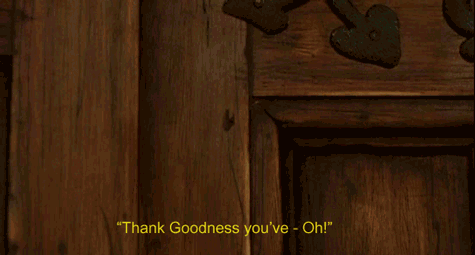
Like Bonham Carter, Fiennes is able to remove all sense of ego and just serve the character Victor is. No stranger to voice over work (notably The Prince of Egypt before this film), Fiennes is able to let loose and have fun with what is essentially a real dirt bag of a person. And although we may not like Victor we love to hate him and I credit both the filmmakers and Fiennes for making that possible.
10) The decision to go with the horror subgenre for this film is an interesting one. Much like how “The Wrong Trousers” felt like a Hitchcock movie, Curse of the Were Rabbit uses the established tropes of horror well by creating a unique atmosphere and having fun with its established tropes. A strong early example of this is when the priest in the film encounters the Were-Rabbit. He’s walking through a gloomy cemetery at night, hears a strange noise, goes into his church and then something is creeping up on him. Something we never really see. You could have opened the film that way and we would’ve understood what kind of tone it was aiming for.
11) There is also a lot of fine misdirection with the Were-Rabbit before the reveal towards the end. It is totally plausible and believable that it is one of Wallace’s rabbits run amok based on the way the filmmakers treat it, but also when you rewatch it you can easily see how the final twist works perfectly even if the filmmakers aren’t as in your face about it.
12) Like all Wallace and Gromit projects, this film has an incredibly strong sense of humor. The town meeting in the church is a wonderful example of this. From the organ player doing a, “dun dun dun!” after a startling statement is made, to this visual:

Strong visual and verbal humor are abound in a way which makes this film wonderfully funny.
13) I’m Gromit in this situation.
Wallace [after Quartermaine asks how they could catch such a big rabbit]: “With a big trap!”
Gromit: [Face palms.]
Townsperson: “By jove, he’s got it!”
[Townspeople start cheering.]
14) The lady rabbit trap is also another wonderful example of humor this film has. It is not only wildly creative but shows off some more of Gromit’s wonderful physical character.

15) While Gromit is alone waiting for Wallace to come back to the car we are given some surprisingly wonderful tension. The noises, the jumps, it is right out of a horror film and works wonderfully well.
16) Wallace transforming into the Were-Rabbit is wonderful. It’s straight out of the Wolf Man and a wonderful piece of animation. It is the big twist of the film: our hero is the monster! And the way everyone reacts to it is just hysterical.
youtube
17) They had to make this joke, didn’t they?
Victor [after the priest says the Were-Rabbit can only be killed with gold]: “Gold?”
Priest: “Yes. 24...carrot. [He chuckles].”
18) The rabbit Hutch turning into Wallace is absolutely fantastic.
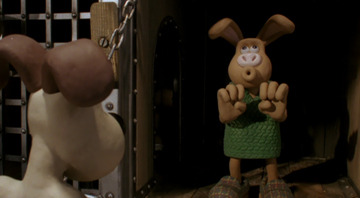
Everything out of Hutch’s mouth is 1) a sped up version of Peter Sallis’ own voice and 2) a line that was either said earlier in this film or in a previous Wallace and Gromit. I think that concept is just hysterical and love that they included it in the film.
19) If you want to understand how wonderfully weird this film is, just consider this line.
Wallace [tearing up]: “Oh Gromit! I don’t want to be a giant rabbit!”
20) There are two jokes which I find straight up hysterical back to back.
Quartermaine [to the police officer]: “I don’t want to cause any panic, but the beast isn’t actually dead yet.”
Police officer [through his megaphone]: “The best isn’t actually dead yet?”
Quartermaine [after firing off a bullet to calm the crowd down]: “Now listen carefully. I’ve only got two [realizes he just shot off a bullet]...ugh, I’ve only ONE gold bullet left!”
21) I just love how THIS is what lets Lady Tottington know the Were-Rabbit is Wallace.
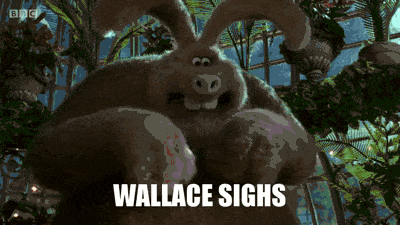
That hand gesture is so iconic for the character that even Hutch the rabbit spoofs it quite frequently.
22) The entire “Dogfight” between Gromit and Quartermain’s dog is an excellent showcase for how the series incorporates amazing action with wildly strong humor (as they did in the train chase in “The Wrong Trousers”). It is by far my favorite scene in the film, and when they have to insert another coin to keep going has my rolling with laughter.
youtube
23) The scene where the Were-Rabbit “dies” and turns back into Wallace is lifted directly from Lon Chaney Jr’s The Wolf Man and I just love that.
24) Of course cheese brings Wallace back and everybody has a happy ending.

25) I just need to get this out of my system:

(GIF originally posted by @marshmallow-the-vampire-slayer)
Wallace and Gromit: The Curse of the Were Rabbit is another excellent piece of animation from Aardman studios. It has the warmth, humor, heart, and characters we’ve come to expect not only from the filmmakers but from the series itself. Peter Sallis SHINES as Wallace and the additions of Helena Bonham Carter and Ralph Fiennes works wonderfully well. It is an excellent piece of animation and filmmaking in general. And I would be regretful if I did not make one last dedication to the late Peter Sallis. He may be gone, but children and fans everywhere will always have the warmth of his voice through the character of Wallace.

#Wallace and Gromit#Peter Sallis#The Curse of the Were Rabbit#Aardman#Nick Park#Helena Bonham Carter#Ralph Fiennes#Epic Movie (Re)Watch#Movie#Film#GIF
406 notes
·
View notes
Text
CINEMA | EARLY MAN
We begin with an affectionately cheeky tribute to the much-loved Hollywood stop-motion master, Ray Harryhausen, à la prehistoric creature feature, 1 Million Years BC (stop looking for Raquel Welsh in a fur bikini – this isn’t that kind of film). Earth; the Neo-Pleistocene-era (get it?); somewhere near Manchester; around about Lunchtime: a meteor strikes the primeval landscape, annihilates a pair of fighting dinosaurs (so long Ray & Harry, we hardly knew ye) and gouges out an enormous crater. Inside, a nearby tribe of cavemen discover a round fragment that looks suspiciously familiar. They make the further discovery that it’s rather a lot of fun to kick about. Thus “the beautiful game” is born! Centuries later however, the empty crater is now a verdant valley, the tribe inhabiting it spending their days happily hunting rabbits, their glorious footballing past relegated to cave paintings whose significance has long been forgotten. And so, the scene is set for Early Man, the latest feature film from Bristol-based animation studio and much-loved British stop-motion powerhouse, Aardman Animations, and the first to be directed by Nick Park (the soften spoken genius behind Wallace & Gromit) since 2005’s Curse of the Were-Rabbit.
Instead of one man and his preternaturally intelligent dog, our heroes for this story are one caveman, Dug (voiced by Eddie Redmayne), and his preternaturally intelligent pig, Hobnob (who, despite being porcine, is more puppy-like than a puppy, and voiced – or rather, grunted – by Park himself). Dug is the eternal optimist, convinced his tribe (given life by some of the cream of British comedy and character acting) can accomplish anything if they just give it ago, starting by hunting something a bit bigger than rabbits, though Chief Bobnar (Timothy Spall) isn’t so sure. But their idyll is shattered by the arrival of an invading bronze age tribe, led by the avaricious Lord Nooth (an unrecognisable Tom Hiddleston, with a hilariously awful comedy French accent so broad even Officer Crabtree would declare it a bit much), who wants to mine their valley for bronze ore, and exiling them to the surrounding “Badlands”. But then Dug discovers that these Bronze-agers venerate football almost as much as they do the precious metal and sees a way for the tribe to try and win back their home. But it’ll take the help of new friend Goona (street vendor and precociously talented footballer, voiced by Maisie Williams) if they’re to really stand a chance.
So, before we go any further, let’s address the woolly mammoth in the room. Is Early Man, with its ‘natives fighting to take back their home from foreign invaders’ (whose colours happen to be blue and yellow), as some have posited, a Brexit film? Short answer: no.
Slightly longer answer: there are some elements that are coincidental for no reason other than timing, over which Aardman had nothing to do with and no control over (the film has been in development for over two years, and an “untitled Nick Park project” was mentioned as far back as 2007). Yes, the tribe are a plucky band of natives trying to take back control of their home, but needless isolation has made them backwards, and later discover that glorious origin stories are often just that – stories. Yes, the Bronze Agers are ruthless and capitalistic (often to the point of arrogance) but they are also cultured and sophisticated. And it’s only by learning to work together that the two sides can come to any sort of accord. This isn’t a Brexit film. This is an ‘underdogs rise to the top through teamwork’ film (or a ‘wish-fulfilment for England fans’ film).
But the most important question to ask, and what we really expect from an Aardman production, is: is it fun? My god, yes it is! (The minute you see a cockroach put on a pair of shades to protect itself from the light from the meteor crash, you know you’re in for a good time.) There are Aardman’s usual gorgeous stop-motion visuals (only delving into digital when wide-angle shots with massive crowds were involved, understandably), combined with their meticulous attention to detail and very distinctive British sense of humour, involving everything from wordplay to slapstick and visual puns to sight gags (too numerous to mention here – though two of my favourites include an advert for toilet roll: “Bumsoft, the world’s no.2 choice”, and Dug scaling the gate of the Bronze city, only for Hognob to get in easily through the cat flap – suffice it to say, you could easily watch it a second and third time just to look for the background gags you missed). The animal characters in particular frequently steal the scene; as well as Hognob, there is a mischievous rabbit that makes repeated appearances and a giant man-eating mallard (don’t question, just go with it).
You might find yourself of the opinion that Early Man doesn’t quite reach the highs of Chicken Run or Were-Rabbit, but even if you do, it’s still a solid film that doesn’t sacrifice good characters or storytelling for style and will ensure you leave the cinema with a smile on your face. It’s even one you don’t have to like or know anything about football (and trust me, I don’t), or bribe a child to see it with you to enjoy. Definitely no own goal!
Originally published: http://www.walesartsreview.org/cinema-early-man/
0 notes